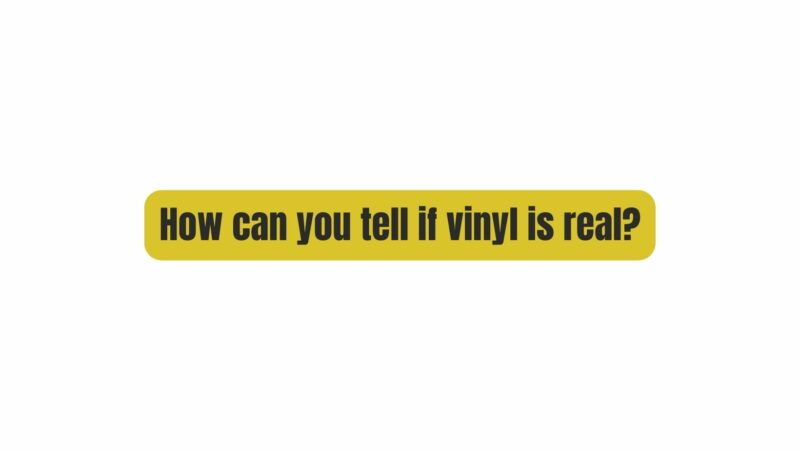Vinyl records, with their timeless appeal and analog warmth, have experienced a remarkable resurgence in recent years. However, as vinyl’s popularity continues to soar, so does the risk of encountering counterfeit or unauthorized records. Distinguishing between authentic and fake vinyl records is essential for collectors seeking to preserve the authenticity and value of their collections. In this comprehensive guide, we will delve into techniques, factors, and resources that can assist you in confidently determining whether your vinyl record is real or a replica.
The Significance of Authentication
Authenticating a vinyl record goes beyond mere curiosity; it carries profound significance for collectors and enthusiasts:
- Value Assessment: Authentication plays a pivotal role in assessing the monetary and historical value of a vinyl record. Original pressings and limited editions often command higher prices in the collector’s market.
- Historical Connection: Original pressings offer a direct link to the era when the music was first released, providing historical and cultural context.
- Collector’s Satisfaction: Owning a real vinyl record brings a sense of pride and satisfaction, knowing you possess a genuine piece of music history.
Key Indicators for Identifying Fake Vinyl Records
To determine if a vinyl record is fake, consider these key indicators:
- Label and Catalog Number: Verify that the label and catalog number on the vinyl record match the official release. Consulting discography databases and reference materials can provide accurate information.
- Matrix Runout: Examine the matrix runout, which is etched into the vinyl’s runout groove area. This code often contains valuable information about the record’s origin, such as the pressing plant, mastering engineer, and catalog number.
- Cover and Packaging: Scrutinize the album cover, artwork, and packaging for specific details, such as design variations, printing quality, and the presence of original shrink-wrap, stickers, or inserts.
- Vinyl Weight and Color: Original pressings may feature heavier vinyl and unique color variations, such as marbled or translucent vinyl. Compare the vinyl’s weight and appearance to known originals.
- Copyright and Publishing Information: Verify that the copyright and publishing details on the record label, cover, and inner sleeves match the official release information.
- Country of Origin: Different countries or regions may produce various pressings of the same album. Knowing the country of origin can offer valuable insights for authentication.
- Vinyl Condition: Inspect the condition of the vinyl itself. Original pressings are often well-preserved, exhibiting minimal signs of wear or use. Beware of records that appear excessively worn or damaged.
- Sound Quality: Listen to the record to assess its sound quality. Original pressings are often celebrated for their superior audio quality compared to reissues or counterfeits.
- Historical Research: Conduct extensive research on the artist, album, and record label to gain historical context and insights into the vinyl record’s authenticity. Explore collector forums, discography databases, and genre-specific reference materials for information.
Resources for Identifying Fake Vinyl Records
To aid in the identification of fake vinyl records, utilize these valuable resources:
- Collector Forums: Online collector forums provide a platform for seeking advice from experienced collectors and discussing authentication challenges.
- Discography Databases: Online discography databases compile comprehensive information about artists, albums, and their various pressings, serving as indispensable reference sources.
- Reference Books: Explore reference books dedicated to vinyl collecting and discographies, offering in-depth insights and documentation of releases.
- Vinyl Grading Guides: Vinyl grading guides assist in accurately assessing the condition of vinyl records, considering factors like surface noise, scratches, and warp.
- Record Collectors’ Guides: Specialized guides authored by vinyl collecting experts offer valuable tips and advice for authentication.
- Professional Appraisers: In cases involving high-value or rare records, consider seeking the expertise of professional appraisers or authenticators.
Conclusion
Identifying whether a vinyl record is fake or authentic is a valuable skill that enhances the experience of vinyl collecting. It empowers collectors and enthusiasts to appreciate the history, rarity, and value of their vinyl treasures fully. Remember that authentication can be a nuanced process, and some factors may not guarantee authenticity on their own. By combining various techniques, reference materials, and resources, you can confidently determine whether your vinyl record is real or a replica. The pursuit of authenticity not only safeguards the record’s legitimacy but also deepens your connection to the rich tapestry of music history embedded within each vinyl groove. With dedication and the knowledge gained from this guide, you can cherish your authentic vinyl records, recognizing their unique place in the world of music.


